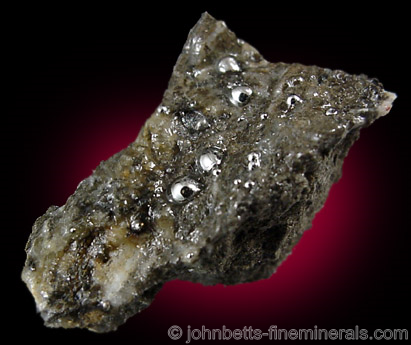The Mineral mercury

Mercury is rare in a native state. Although it is a naturally occurring liquid substance, it is never found in "pools". It only occurs as very small blobs on top of mercury ores such as Cinnabar. The tiny blobs are lodged in small crevices or pores, or just stick to the host mineral. The blobs do not roll around or fall off, but stay attached in position unless tampered with.
Mercury freezes at -38º F (-39º C), and when it solidifies, it crystallizes in the isometric crystal system. (Under high pressure it crystallizes in the tetragonal crystal system.) Mercury boils at a very low temperature, and disappears as fumes when heated.
Because Mercury is a liquid, it is not possible for it to have the properties of streak, hardness, cleavage, or crystals.
Properties
Streak
- |
Hardness
0 |
Transparency
Opaque |
Specific Gravity
13.5 |
Luster
Metallic |
Cleavage
- |
Fracture
- |
Tenacity
- |
Other ID Marks
1) Occurs in a liquid state.
2) Excellent conductor of electricity. |
Crystal Habits
Mercury occurs as small liquid blobs perched atop or in the crevices of mercury ores. Since Mercury is a liquid, it lacks a crystal structure and technically is not really a mineral but a mineraloid. However, most reputable mineral guides, including the acclaimed Dana's System of Mineralogy, categorize Mercury together with the "true" minerals.
Uses
Native Mercury is only of use to the mineral collector as a specimen of interest. The amount of mercury mined with the ores is too insufficient to mention Mercury as an ore, although its occurrence is always with other mercury ores.
Mercury as an element has many industrial uses, as it is the only metal that is a liquid at room temperature. It is used in many scientific and household devices, such as the mercury thermometer. When mercury combines with any of the true metals (excluding platinum and iron), the result is an amalgam. (There is also a mineral known as "Amalgam", which is a composed of silver and mercury (Ag,Hg), but the common term of amalgam denotes a mixture of mercury and any other metal.) Amalgams are used to extract precious metals from their ore.
Ingested mercury and mercury mixtures are health hazards, and be lethal if a large amount is ingested. In fact, some mercury mixtures are used as poison. Hands should be washed after handling any minerals containing mercury. Mercury should also never be heated, as the vapor can be deadly if inhaled.
Noteworthy Localities
The locality that yields the most and the finest Native Mercury for collectors is Almadén, Ciudad Real, Spain, where small blobs are found in the host Cinnabar. Many small blobs have also come from the mercury mines in Idrija, in former Yugoslavia (Slovenia) and in the Levigliani mine in Stazzema, Tuscany, Italy.
In the U.S., Mercury occurs in several California mercury mines, specifically the Almaden and New Almaden mines in Santa Clara Co.; the Socrates Mine, Sonoma Co.; and the New Idria District, San Benito Co.
Common Mineral Associations
Cinnabar, Calomel, Quartz, Dolomite
Distingushing Similar Minerals
The distinctive properties of Mercury and its environment can distinguish it from every mineral.